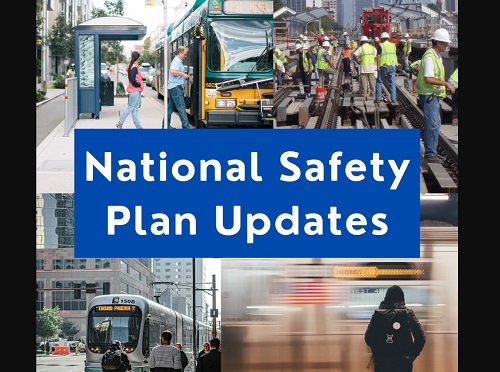The Federal Transit Administration recently issued a final rule updating its Public Transportation Agency Safety Plans or PTASPs, while issuing a newly-revised National Public Transportation Safety Plan as well.
[Above image by FTA]
The agency said those major safety updates should make transit systems safer for transit workers and passengers alike nationwide, while also providing workers more input in safety-making decisions through enhanced safety committees.

“Millions of Americans depend on safe, reliable public transportation every year, and transit workers deserve to be safe when they’re delivering this essential service,” said Pete Buttigieg, secretary of the U.S. Department of Transportation, in a statement.
“These improved safety measures will enhance the safety of public transportation by empowering transit agencies and workers to identify risks, find solutions to mitigate those risks, and ensure the solutions are properly carried out,” he added.
“The safe operation of public transit is FTA’s top priority,” noted FTA Acting Administrator Veronica Vanterpool. “[These updates] reflect our continued commitment, in cooperation with our state and industry partners, that every rider of public transit has a safe and reliable transportation experience.”
The FTA noted that the changes to its PTASP rule apply to more than 700 transit agencies nationwide, including requirements for transit agencies serving areas with a population of 200,000 or more that largely coincide with the most significant increases in reported assaults on transit workers.

As a result, those agencies are required to establish safety committees with equal numbers of frontline transit worker and management representatives to address safety issues.
The updated PTASP regulation includes specific requirements for safety committee membership, procedures, and responsibilities to provide frontline workers more input into safety decision-making.
A safety committee can recommend safety improvement strategies based on the agency’s safety risk reduction program. If approved as part of the larger agency safety plan, transit agencies are required to implement the safety risk mitigations, FTA said – which includes preventing assaults on transit workers and vehicle-pedestrian collisions.
Meanwhile, revisions to the agency’s National Safety Plan aim to “create a blueprint” in FTA’s words for transit agencies to adopt stronger safety practices, including mandatory performance measures for transit agencies subject to the PTASP regulation to address assaults on transit workers.
The updated safety plan incorporates 22 performance measures, including eight measures for safety risk reduction programs, FTA said. Joint labor-management safety committees will now use these measures to set risk reduction performance targets focused on reducing the number and rates of accidents, injuries, and assaults on transit workers, the agency added.
That updated plan also includes best practices, tools, technical assistance, voluntary standards, and other resources for transit agencies to improve their safety performance related to major events, collisions, and injuries.
The FTA noted that the updated National Safety Plan also supports USDOT’s goal of making transportation systems safer for all – a key tenet of the agency’s National Roadway Safety Strategy, launched in January 2022, as well as a critical cornerstone of FTA’s Bus-to-Person Collision Safety Advisory, which calls on transit agencies to assess this safety concern and consider strategies to reduce these types of collisions that accounted for 15 percent of all transit fatalities between 2008-2021.
 Top Stories
Top Stories


